The following components in Teletypewriters TT-47A/UG, TT-48A/UG, TT-69A/UG, and
TT-70A/UG differ from the corresponding ones in Teletypewriters TT-47/UG, TT-48/UG,
TT-69/UG and TT-70/UG.
(1) POWER DISTRIBUTION PANEL SB-154A/UG.- This component differs from SB-154/UG principally in that the connectors on the ends of the cables leading to the Keyboard and to the Automatic Typer have been changed. Therefore, it cannot be connected to the
MX-1114/UG Keyboard or to the MX-1115/UG Automatic Typer.
{2) KEYBOARD MX-1114A/UG.-This component differs from MX-1114/UG in several respects. It has a 20 terminal receptacle, whereas the
MX-1114/UG has a 14 terminal receptacle. Thus this component cannot be connected to a
SB-154/UG Power Distribution Panel. The spring powered throwout mechanism has been removed from the
MX-1114A/UG clutch. The position of the repeat key has been shifted to the right and the repeat mechanism has been redesigned. Several changes have also been made in the adjustments, and in the lubricating procedure.
(3) AUTOMATIC TYPER MX-1115A/UG .- This component differs from MX-1115/UG in several major respects and in numerous minor details. Since the changes in adjustments are many and varied, the adjustment requirements specified in Section 7 of this instruction book must be adhered to. The
MX-1115A/UG has a 20 terminal receptacle, whereas the MX-1115/UG has a 14 terminal receptacle. Consequently, this component cannot be connected to a
SB-154/UG Power Distribution Panel. The MX-1115A/UG has a new main shaft, and a redesigned selector mechanism with an improved method for orienting the range finder. The ribbon feed mechanisms have been revised to include an improved slack take up feature and improved feed pawl adjustment. The range of the automatic carriage return-line feed arm on the spacing drum has been increased to accommodate a maximum of 85 characters per line. Also, several ratchet teeth have been removed from the spacing drum to prevent over spacing in the event of spacing clutch stop failure or spacing suppression failure. Changes in the lubrication procedure are few.
Mark I Keyboard - LK1, LK2?
|
2-row connector on keyboard base
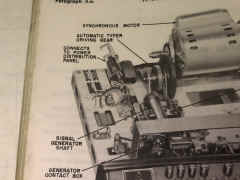 |
LESU with 2-row connectors
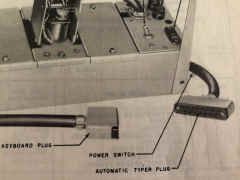 |
Wiring Diagram
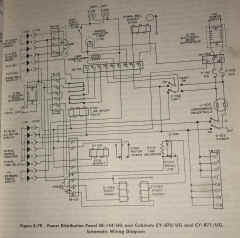 |
Motor unit LMU 1 (PD-17/U) used for the first 76 KSRs, after
that LMU3 (PD-17A/U). LMU1 has a centrifugal starter switch.
What was the LMU2 ?
|
Mark II Keyboard - LK3, LK4, LK5, LK7
- some Mark II keyboard parts
drawings
|
Keyboard transmitter
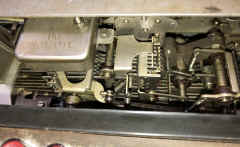 |
Keyboard mechanism protector bar
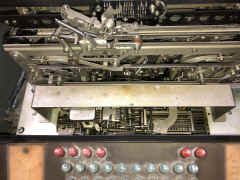 |
Keyboard cover (hood) top view
Mark III above, Mark II below
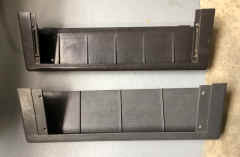 |
Keyboard cover (hood) bottom view
Mark III above, Mark II below
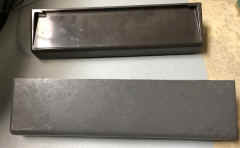 |
Mark III Keyboard - LK6, LK8 and on
|
keyboard transmitter
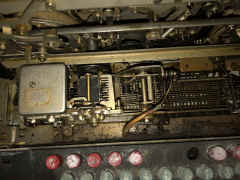 |
No protector bar |
Keyboard cover (hood) top view
Mark III above, Mark II below
 |
Keyboard cover (hood) bottom view
Mark III above, Mark II below
 |
Mark I Printer - LP1, LP2? - almost the same as Mark II?
|
slotted ribbon carriage rail (black)
slotted typebox carriage rail (steel)
(note that this is a flat piece with larger holes than Mark II)
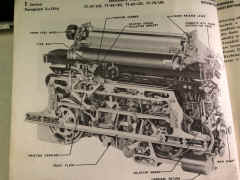 |
Type box carriage rail A-1324
Teletype Part 150844
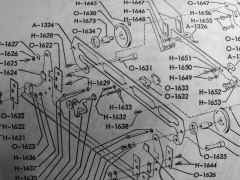 |
2-row electrical connector
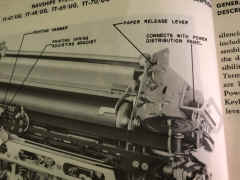 |
2-row connector J-1301
Teletype Part 151815
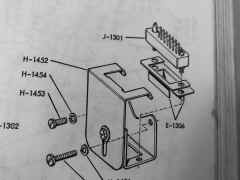 |
Mark II Printer - LP3, LP4, LP5, LP6, LP7, LP8, LP9
- some Mark II printer parts drawings
|
Left side of printer
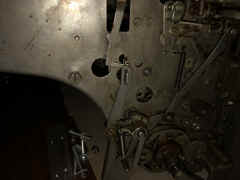 |
solid ribbon spool retainer clips
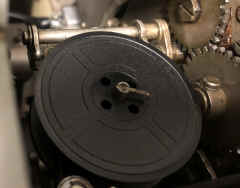 |
slotted ribbon carriage rail (black)
slotted typebox carriage rail (steel)s
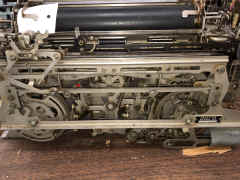 |
slotted ribbon carriage rail (black)
slotted typebox carriage rail (steel)
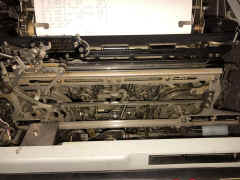 |
Mark III Printer - LP10 and on
|
Left side of printer
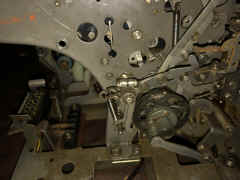 |
wire ribbon retainer clips
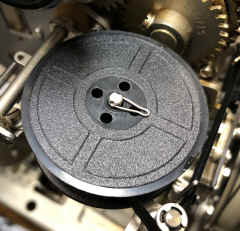 |
round hole ribbon carriage rail (black)
unslotted typebox carriage rail (steel)
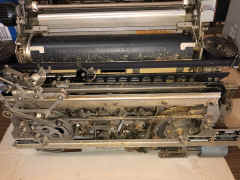 |
Hybrid or updated? Mk II solid ribbon retainer clip
and Mk II left side with Mk III round hole ribbon carriage rail (black) and
Mk III unslotted typebox carriage rail (steel)
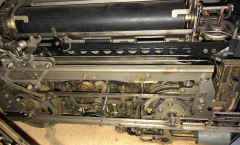 |